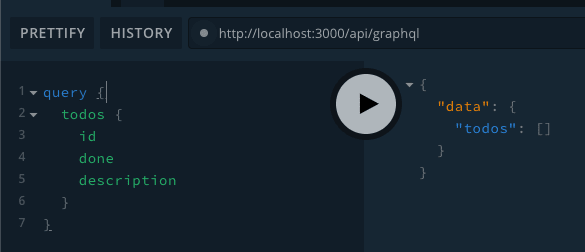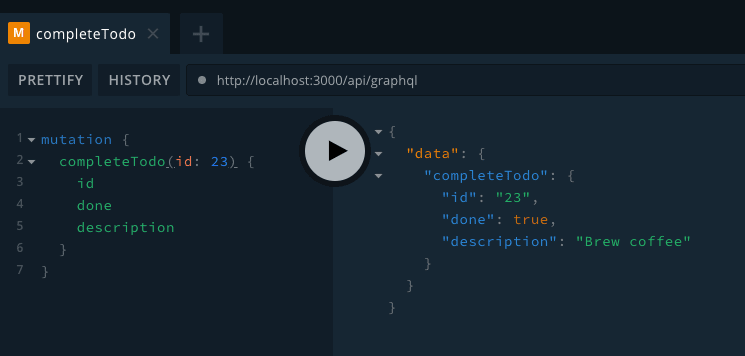Full stack web app with NextJS and Graphql
When we talk about developing a front end application with ReactJS we can find 3 main options. CRA which focuses on building single-page web applications but having difficulty with CEO positioning. Gatsby which focuses on static site generation with great performance, with cool CEO and data-fetching. And then we have NextJS, in my opinion, the best way to write ReactJS web applications nowadays, server-side rendering with the option of making it client-side, cool built-in routing, 0 configuration philosophy, and since NextJS 9, this framework provides API routes which is a really easy way to provide back-end to our react app and which we are going to be using for this post. In this post, we are going to learn how we can implement a GraphQL API running over an API route.
The basic NextJS app
As I mentioned before NextJS focuses on a 0 configuration philosophy we can easily configure it but to make it even easier let's just type npx create-next-app todo-app in our terminal to have it ready to use. Once the project is setup let's cd todo-app and type yarn dev to run the server and see that everything is running.
The API Route
Cool!, We now have our nextjs web app up and running. Let's create a new file inside pages/api/ called graphql.js and let's add the following code:
export default (req, res) => {
res.statusCode = 200
res.send("GRAPHQL")
}
And if we go to localhost:3000/api/graphql we'll be able to see the text GRAPHQL written. Easy!. Let's now configure GraphQL!.
GraphQL setup
Install it
First, let's add a dependency called apollo-server-micro by writing yarn add apollo-server-micro
Our Schema
The next thing we need to work with graphql is Writing our schema, which will define the Queries and Mutations we have and how the data is structured. For now, we want to have a query called hello which will return a string. So let's add the following to the top of our route.
import { ApolloServer, gql } from 'apollo-server-micro'
const schema = gql`
type Query {
hello: String!
}
`;
Resolvers
We have just written our schema, but now GraphQL needs the resolvers of our schema, which tells graphql where to fetch our data from. Below the schema let's add our resolvers.
const resolvers = {
Query: {
hello: (_parent, _args, _context) => "world!"
}
}
The server
Now let's create our server with our schema and resolvers.
const apolloServer = new ApolloServer({
typeDefs: schema,
resolvers,
context: () => {
return {}
}
})
Cool, with this instance we can access a handler, in charge of handling all the requests and responses and as we are actually working with NextJS we need to specify it that we don't need bodyParser in our requests.
Let's remove the last export default and change it for the following
const handler = apolloServer.createHandler({ path: "/api/graphql" });
export const config = {
api: {
bodyParser: false
}
};
export default handler;
Okay, we have now a basic configuration of a GraphQL server, why don't we go to localhost:3000/api/graphql and see what we have now!
and if we run the following
query {
hello
}
We will have our response from the resolver.
CORS
We need another thing to use this API from the front end, so let's add a new package by typing yarn add micro-cors, and let's add the following.
import Cors from "micro-cors";
const cors = Cors({
allowMethods: ["POST", "OPTIONS"]
});
// Here is how we connect our handler with cors.
export default cors(handler);
Data from Postgres with Knex.
At some point, our app would need some sort of access to a database to persist some data. For this, we will need to set up some stuff so let's do it! First Let's add knex and Postgres with yarn add knex pg
Now let's create a file called knexfile.js with our database configuration.
module.exports = {
development: {
client: "postgresql",
connection: "postgres://postgres@localhost:5432/todo",
migrations: {
tableName: "knex_migrations"
}
},
};
Next, let's create our first migration, which will tell Postgres how to create our tables, let's start by typing yarn run knex migrate:make create_todo and inside the folder migrations will have a new file generated, let's open it and add how we want our table to be created.
exports.up = function(knex) {
return knex.schema.createTable("todos", function(table) {
table.increments("id");
table.string("description", 255).notNullable();
table.boolean("done").defaultTo(false).notNullable();
});
};
exports.down = function(knex) {
return knex.schema.dropTable("todos");
};
And let's build our table!. Run yarn run knex migrate:up
Now we need to create a constant which will help us manage the database inside our code. Let's open /pages/api/graphql.js and add the following.
import knex from "knex";
const db = knex({
client: "pg",
connection: "postgres://postgres@localhost:5432/todo"
});
Updating our schema
Cool, we can now work. Why don't we change our schema and resolvers?
const schema = gql`
type Query {
todos: [Todo]!
todo(id: ID!): Todo
}
type Todo {
id: ID!
description: String!
done: Boolean!
}
`;
const resolvers = {
Query: {
todos: (_parent, _args, _context) => {
return db
.select("*")
.from("todos")
.orderBy("id")
},
todo: (_parent, { id }, _context) => {
return db
.select("*")
.from("todos")
.where({ id })
.first()
}
}
}
And if we now go to localhost:3000/api/graphql we'll finally be able to fetch and play with our data!
But wait a minute... How are we going to create data?
Well...
Let's go and see how we can add a Mutation which will help us create data inside our database!
Creating data
First, we have to add a new type inside our schema. We first need to specify the name of the mutation in this case createTodo and then inside the parenthesis the names and types of values that we will receive, at the end, we need to specify what our mutation will return, in this case, a Todo type.
const schema = gql`
...
type Mutation {
createTodo(description: String!, done: Boolean): Todo
completeTodo(id: ID!): Todo
}
`;
Now inside our resolvers object let's add the new Mutation key and the createTodo
const resolvers = {
...
Mutation: {
createTodo: async (_, { description, done }, _c) => {
return (await db("todos").insert({ description, done }).returning("*"))[0]
},
completeTodo: async (_, { id }, _c) => {
return (await db("todos").select("*").where({ id }).update({ done: true }).returning("*"))[0];
}
}
}
And with this, now we can create and complete todos in our database
Cool, but what about the Front-end?
The client
Until now we have been building the server-side of our application by integrating graphql in an API route, why don't we integrate the client side of our app?
Dependencies
Let's start by adding two dependencies we need to connect to GraphQL
yarn add @apollo/react-hooks apollo-boost
Provider
First let's setup the Apollo Client of our app. for this let's open pages/_app.js and add the following:
import '../styles/globals.css'
import { ApolloProvider } from '@apollo/react-hooks';
import ApolloClient, { gql } from 'apollo-boost';
function MyApp({ Component, pageProps }) {
const client = new ApolloClient({
uri: "http://localhost:3000/api/graphql"
})
return (
<ApolloProvider client={client}>
<Component {...pageProps} />
</ApolloProvider>
)
}
export default MyApp
Query
Now let's open our pages/index.js and import what we are going to need
import React, { useState } from 'react';
import { useQuery, useMutation } from "@apollo/react-hooks";
import { gql } from 'apollo-boost';
Now, we first need to declare our GraphQL query, exactly as we would do in the GraphQL Playground
const GET_TODOS = gql`
query {
todos {
id
description
done
}
}
`
Now inside our component, we are going to use the query and map through them to render them in the app
export default function Home() {
const { loading, error, data, refetch } = useQuery(GET_TODOS);
if(loading) return <p>Loading...</p>
if(error) return <p>ERROR :(</p>
return (
<div>
<h1>My TODO list</h1>
{
data.todos.map((todo) => (
<div key={todo.id}>
{todo.description}
<button
disabled={todo.done}
>
{todo.done ? "Done" : "Complete"}
</button>
</div>
))
}
</div>
)
}
Cool, now we should be seeing our todos on the browser. Now let's add a way to create todos. Let's start by adding the createTodo mutation
const CREATE_TODO = gql`
mutation CreateTodo($description: String!) {
createTodo(description: $description) {
id
description
done
}
}
`
Now inside our component, we add some state management, our mutation, and our form to perform the mutation to end up like this:
export default function Home() {
...
const [todo, setTodo] = useState("");
const [createTodo] = useMutation(CREATE_TODO);
const saveTodo = async (e) => {
e.preventDefault();
await createTodo({variables: { description: todo }});
refetch();
setTodo("")
}
...
return (
<div>
<h1>My TODO list</h1>
<form onSubmit={saveTodo}>
<label>
New todo
<input onChange={e => setTodo(e.target.value)} value={todo} />
</label>
<button type="submit">Save</button>
</form>
...
</div>
)
}
Completing todos
Pretty straightforward!, Why don't we add our completeTodo mutation and add functionality to our buttons?
Here we have our mutation declaration:
const COMPLETE_TODO = gql`
mutation CompleteTodo($id: ID!) {
completeTodo(id: $id) {
id
}
}
`
And inside our component we have:
export default function Home() {
const [todo, setTodo] = useState("");
const { loading, error, data, refetch } = useQuery(GET_TODOS);
const [createTodo] = useMutation(CREATE_TODO);
const [completeTodo] = useMutation(COMPLETE_TODO)
const saveTodo = async (e) => {
e.preventDefault();
await createTodo({variables: { description: todo }});
refetch();
setTodo("")
}
const onComplete = async (id) => {
await completeTodo({variables: { id }});
refetch();
}
if(loading) return <p>Loading...</p>
if(error) return <p>ERROR :(</p>
return (
<div>
<h1>My TODO list</h1>
<form onSubmit={saveTodo}>
<label>
New todo
<input onChange={e => setTodo(e.target.value)} value={todo} />
</label>
<button type="submit">Save</button>
</form>
{
data.todos.map((todo) => (
<div key={todo.id}>
{todo.description}
<button
disabled={todo.done}
onClick={() => onComplete(todo.id)}
>
{todo.done ? "Done" : "Complete"}
</button>
</div>
))
}
</div>
)
}
And if now we go to our browser we can see our app working!
Conclusion
GraphQL is a technology that has been growing a lot in the last couple of years and so has NextJS. And now that we can have API routes in our NextJS app we can integrate them to build a delightful stack and be able to have a full-stack web application as a monolith but which can even run serverless 🤔?
Photo by Alina Grubnyak on Unsplash








Top comments (0)